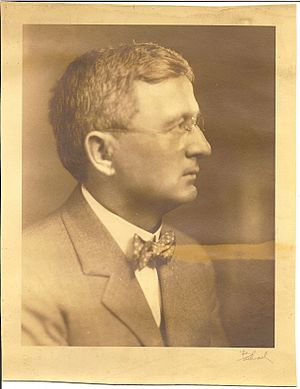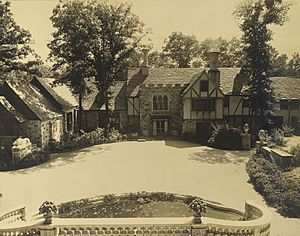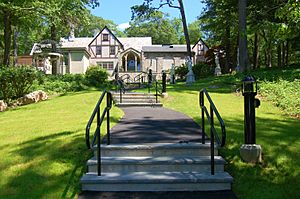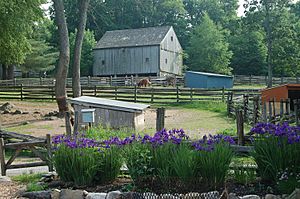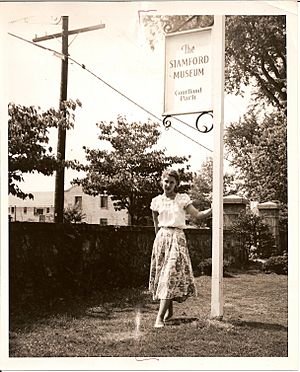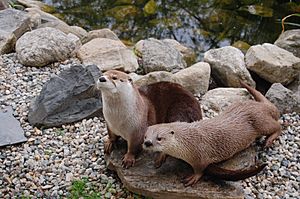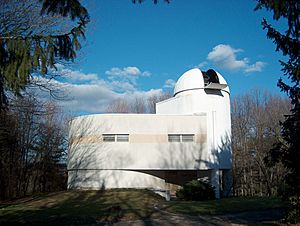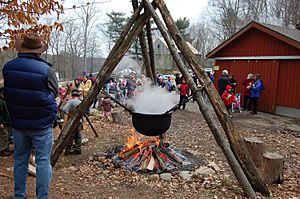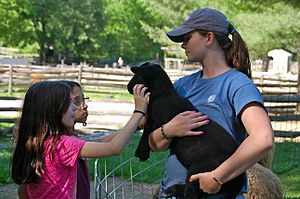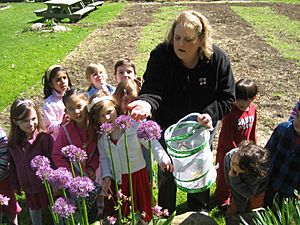- This page was last modified on 17 October 2025, at 10:18. Suggest an edit.
Stamford Museum & Nature Center facts for kids
The Stamford Museum & Nature Center is a super cool place in Stamford, Connecticut. It's like a giant outdoor classroom! You can learn about art, history, nature, and even how farms work. This amazing property covers 118 acres, which is about 48 football fields! It used to be a private home.
This huge museum property is tucked away in the woods of North Stamford. It has a 10-acre working farm, a beautiful old museum building (that looks like a castle!), a fun nature center, and 80 acres of trails to explore. There's also a planetarium to see stars, a tall observatory with a powerful telescope, a pond where otters play, and a playground designed to help kids see nature from an animal's point of view.
The Stamford Museum & Nature Center also has special events for families all year, like festivals and exhibits. They offer educational programs, camps, and even ways for kids to volunteer and help out.
Contents
A Look Back: The Museum's History
The idea for the museum started in 1936. Its founders wanted a safe and fun place where kids and families could learn. They dreamed of a spot to explore nature, farming, space, art, and history. Dr. G.R.R. Hertzberg helped bring this idea to life.
The Stamford Museum first opened on June 27, 1936. It was a small "cabinet of curiosities" in three rooms downtown. People from the community donated birds, butterflies, rocks, and other cool items. Families loved visiting, and they still do today!
Over the years, the museum grew. In 1938, new rooms opened for mammals and geology. The city of Stamford started helping the museum with money in 1939. This allowed it to grow even more.
By 1945, the museum needed a bigger home. It moved to Courtland Park, where it had eight acres. An old carriage house became the new museum. They built a small barnyard and a wildlife area. Local artists showed their work, and a planetarium was added.
This location didn't last long. In 1955, a new highway took six of the eight acres. So, the museum had to find a new, even larger place.
Finding a Forever Home
In 1955, the museum moved to its current home. This was once the huge estate of Henri Bendel, a famous department-store owner. He built his dream "castle" in North Stamford in the late 1920s. After he passed away, his estate was given to the Stamford Museum.
The large, castle-like mansion became the perfect spot for the museum's growing collections. When it moved, "Nature Center" was added to its name. The Heckscher Farm for Children also opened that same year.
Since then, the museum has gotten even bigger! More land was added, bringing its total size to 118 acres. This allowed for more trails and exhibits.
Explore the Facilities
The Bendel Mansion: A Castle of Learning
The Bendel Mansion was built in the late 1920s. Architect Perry Barker designed it to look like a grand British manor house. It was inspired by two Tudor mansions in England. This house was Henri Bendel's idea of an American "castle."
The mansion sits on a hill overlooking a lake. It has cool features like lead-framed glass windows, half-timbered walls, and even gargoyles! Today, the Bendel Mansion is a gallery and museum. It's open for everyone to explore.
Museum Displays: Art, History, and Nature
The museum has always loved art. It started by showing local artists. Over time, generous people donated amazing artworks. In 1956, it received a portrait by John Singer Sargent. In 1961, it got a collection of 20th-century American art.
Today, the museum focuses on five main areas:
- The natural history of New England.
- American art.
- Native American art and culture.
- American history and culture.
- Old farming tools.
You can see many interesting things here. These include totem poles from a World's fair, telescopes, outdoor sculptures, and Native American artifacts. There are even prints by famous artists like Andy Warhol and Salvador Dalí!
Heckscher Farm: A Working Farm Experience
The Heckscher Farm is a 10-acre (40,000 m2) working farm. It shows what rural life in New England was like long ago. You can see barns, a maple sugar house, gardens, and open fields. Dozens of farm animals live here!
The farm has grown a lot since 1955. It started as a small dairy farm. Now it has a chicken coop, pig pen, and larger pastures. You can see many different kinds of farm animals, including llamas, alpacas, and burros. Visitors can watch the staff do daily chores and learn about farm life.
Farm History: From Small Beginnings
The museum first had farm animals and wildlife at its Courtland Park location. A small farmyard had a lamb, a goat, chickens, and rabbits. Many injured animals were brought to the museum. Students called "Junior Curators" helped care for them. This program still exists today!
When the museum moved in 1955, it could build a bigger farm. A donation helped build the red barn and silo that many visitors know. Over the next 20 years, Heckscher Farm added more wildlife exhibits. These included foxes, porcupines, and birds of prey. A medical facility was also built to care for the animals.
In 1977, the museum decided to create a farm that looked like those in Southern New England in the 1800s. Stamford was changing from a quiet town to a busy city. Small farms were disappearing fast.
Over five years, the farm changed a lot. Land was cleared for pastures. An amazing historic barn from 1750 was moved from another town and rebuilt here. The farm became home to animals typical of that time, like oxen, sheep, cows, pigs, goats, and chickens.
Overbrook Nature Center and Trails
The Overbrook Nature Center is where many of the museum's nature and education programs happen. It has an interactive exhibit area with small local animals. There's also "Nature's Classroom" for student groups. Behind the building, you'll find miles of walking trails.
These trails wind through 80 acres of the museum's land. They are full of wildlife! You can see seasonal pools, huge rocks left by glaciers, old forests, and meadows. The trails even connect to the 88-acre Bartlett Arboretum and Gardens to the north.
In 2006, a special trail called "Wheels in the Woods Trail #7" was added. This trail is accessible for people using wheelchairs, so everyone can enjoy nature.
Edith and Robert Graham Otter Pond
The Edith and Robert Graham Otter Pond is home to the museum's playful river otters. In May 2023, an otter named Ron joined Sadie after Bert passed away a few months earlier.
Observatory and Planetarium: Exploring Space
The Stamford Museum & Nature Center has a four-story observatory. It holds a huge 22-inch (560 mm) telescope! This telescope is used for research by the Fairfield County Astronomical Society. The observatory is currently closed to the public. The museum is raising money to build a new Astronomy & Physical Science Center.
The museum's space history began in 1941. That's when the Fairfield County Astronomical Society was formed. Members would bring their telescopes to look at the stars. At Courtland Park, a planetarium was built inside a lecture hall. It had a dome that could be raised and lowered for shows.
This was one of the first Armand Spitz planetariums. Mr. Spitz wanted to make planetariums affordable for more places. In 1947, he designed a very inexpensive model. He used a 12-sided shape (a dodecahedron) to project the stars.
After showing his invention, Spitz became famous. He sold his Model A planetarium for $500. These were bought by military schools, small museums, and even royalty! Later models could project more stars and even the Sun, Moon, and planets.
After moving to Scofieldtown Road, a new planetarium was built inside the main building. In 1960, an observatory was also built. Local companies donated materials, and volunteers built the telescope. The largest telescope in the East for public viewing was opened on June 13, 1965.
Heckscher WILD! Live Exotic Animal Exhibit In March 2015, the museum opened Heckscher WILD! This exhibit features animals from all over the world that cannot be released into the wild. You can see them in four different environments: grasslands, rainforest, mountains, and desert.
Fun Events and Activities
Annual Events for Families
Harvest Fest Sundays
Every fall, the museum hosts its Harvest Fest Sundays. These days are packed with fun seasonal activities! You can watch apple cider being made, go on hayrides, try apple slingshots, carve pumpkins, and see farm animal demonstrations. There's also face painting, storytelling, crafts, and a costume parade.
Maple Sugar Fest Sundays
In late winter, the museum celebrates maple sugaring! This New England tradition is brought to life during Maple Sugar Fest Sundays. At the Heckscher Farm sugarhouse, you can see how maple trees are tapped and how sap is collected. You can even taste the sweet maple sugar! Other activities include scavenger hunts, storytellers, face painting, maple-themed crafts, and a pancake brunch.
Spring on the Farm Fests
The Stamford Museum & Nature Center hosts its family-friendly Spring on the Farm Fests Sundays in May. It's a great way to welcome spring!
Model T's to Mustangs Antique & Classic Car Show
Each spring, the museum used to host an antique and classic car show. It featured cars from 1900 to 1979, both American and imported. The event also highlighted a special brand of car each year. The museum stopped this event after its 20th year.
Past Exhibitions and Events
The museum has hosted many exciting exhibitions over the years:
- 1942 – A wartime exhibit called Camouflage in Nature and its Uses in the Military.
- 1944 – The museum's first show featuring Gutzon Borglum, the sculptor of Mount Rushmore.
- 1971 – Open House Moon Rock was on display.
- 1973 – Henry Moore's Elephant Skull was shown.
- 2008 – Architecture of the Imagination: The Lure of the LEGO Brick exhibition. This show, featuring sculptures by Nathan Sawaya and a huge train display by Bill Probert, brought in a record 69,000 visitors!
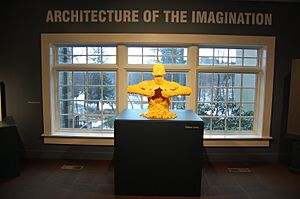
Architecture of the Imagination: The Lure of the LEGO Brick exhibition
Education for All Ages
The Stamford Museum & Nature Center offers classes and educational programs all year long. These programs cover art, nature, science, and farming. They are available for children, families, and adults who want to learn more!



